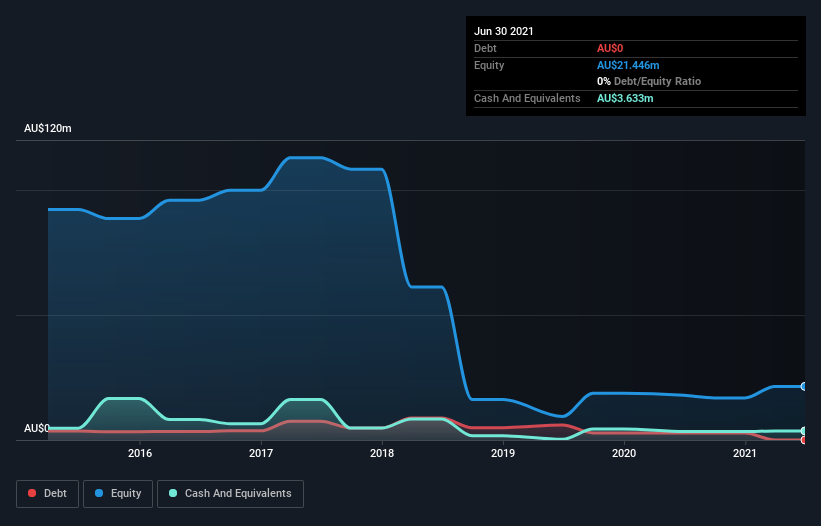We're Not Worried About Carnegie Clean Energy's (ASX:CCE) Cash Burn
Even when a business is losing money, it's possible for shareholders to make money if they buy a good business at the right price. For example, although software-as-a-service business Salesforce.com lost money for years while it grew recurring revenue, if you held shares since 2005, you'd have done very well indeed. But while the successes are well known, investors should not ignore the very many unprofitable companies that simply burn through all their cash and collapse.
Given this risk, we thought we'd take a look at whether Carnegie Clean Energy (ASX:CCE) shareholders should be worried about its cash burn. In this report, we will consider the company's annual negative free cash flow, henceforth referring to it as the 'cash burn'. First, we'll determine its cash runway by comparing its cash burn with its cash reserves.
View our latest analysis for Carnegie Clean Energy
When Might Carnegie Clean Energy Run Out Of Money?
A cash runway is defined as the length of time it would take a company to run out of money if it kept spending at its current rate of cash burn. In June 2021, Carnegie Clean Energy had AU$3.6m in cash, and was debt-free. Importantly, its cash burn was AU$1.1m over the trailing twelve months. That means it had a cash runway of about 3.2 years as of June 2021. A runway of this length affords the company the time and space it needs to develop the business. Importantly, if we extrapolate recent cash burn trends, the cash runway would be noticeably longer. The image below shows how its cash balance has been changing over the last few years.
How Is Carnegie Clean Energy's Cash Burn Changing Over Time?
In our view, Carnegie Clean Energy doesn't yet produce significant amounts of operating revenue, since it reported just AU$61k in the last twelve months. Therefore, for the purposes of this analysis we'll focus on how the cash burn is tracking. Even though it doesn't get us excited, the 46% reduction in cash burn year on year does suggest the company can continue operating for quite some time. Admittedly, we're a bit cautious of Carnegie Clean Energy due to its lack of significant operating revenues. We prefer most of the stocks on this list of stocks that analysts expect to grow.
How Easily Can Carnegie Clean Energy Raise Cash?
Even though it has reduced its cash burn recently, shareholders should still consider how easy it would be for Carnegie Clean Energy to raise more cash in the future. Issuing new shares, or taking on debt, are the most common ways for a listed company to raise more money for its business. Many companies end up issuing new shares to fund future growth. By comparing a company's annual cash burn to its total market capitalisation, we can estimate roughly how many shares it would have to issue in order to run the company for another year (at the same burn rate).
Since it has a market capitalisation of AU$30m, Carnegie Clean Energy's AU$1.1m in cash burn equates to about 3.8% of its market value. Given that is a rather small percentage, it would probably be really easy for the company to fund another year's growth by issuing some new shares to investors, or even by taking out a loan.
Is Carnegie Clean Energy's Cash Burn A Worry?
It may already be apparent to you that we're relatively comfortable with the way Carnegie Clean Energy is burning through its cash. For example, we think its cash runway suggests that the company is on a good path. And even its cash burn reduction was very encouraging. Looking at all the measures in this article, together, we're not worried about its rate of cash burn, which seems to be under control. On another note, Carnegie Clean Energy has 4 warning signs (and 1 which is significant) we think you should know about.
Of course, you might find a fantastic investment by looking elsewhere. So take a peek at this free list of interesting companies, and this list of stocks growth stocks (according to analyst forecasts)
Have feedback on this article? Concerned about the content? Get in touch with us directly. Alternatively, email editorial-team (at) simplywallst.com.
This article by Simply Wall St is general in nature. We provide commentary based on historical data and analyst forecasts only using an unbiased methodology and our articles are not intended to be financial advice. It does not constitute a recommendation to buy or sell any stock, and does not take account of your objectives, or your financial situation. We aim to bring you long-term focused analysis driven by fundamental data. Note that our analysis may not factor in the latest price-sensitive company announcements or qualitative material. Simply Wall St has no position in any stocks mentioned.

 Yahoo Finance
Yahoo Finance 
